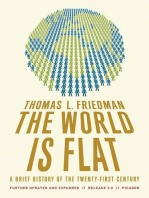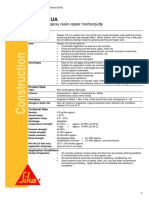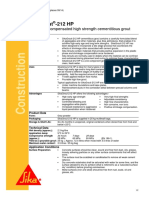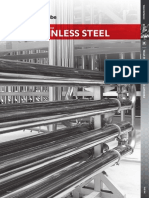0 ratings0% found this document useful (0 votes)
18 viewsKiwiRail W0403 - Reinforced Concrete Construction
KiwiRail W0403 - Reinforced Concrete Construction
Uploaded by
Anonymous jbvNLNANLICopyright:
© All Rights Reserved
Available Formats
Download as PDF or read online from Scribd
KiwiRail W0403 - Reinforced Concrete Construction
KiwiRail W0403 - Reinforced Concrete Construction
Uploaded by
Anonymous jbvNLNANLI0 ratings0% found this document useful (0 votes)
18 views13 pagesCopyright
© © All Rights Reserved
Available Formats
PDF or read online from Scribd
Share this document
Did you find this document useful?
Is this content inappropriate?
Copyright:
© All Rights Reserved
Available Formats
Download as PDF or read online from Scribd
Download as pdf
0 ratings0% found this document useful (0 votes)
18 views13 pagesKiwiRail W0403 - Reinforced Concrete Construction
KiwiRail W0403 - Reinforced Concrete Construction
Uploaded by
Anonymous jbvNLNANLICopyright:
© All Rights Reserved
Available Formats
Download as PDF or read online from Scribd
Download as pdf
You are on page 1of 13
Pago 1 of 13
NEW ZEALAND RAIL LTD
Operations Group : Code Supplement
| Numb: CSw/0403 |
Subject: REINFORCED CONCRETE
CONSTRUCTION
issue | Prepared (P), Reviewed (R), Amended (A) By:
Number
2 {A) PS Holmes
If this Statement i:
in RED, this is a
CONTROLLED POCUME!
This Document Supersedes cawma0g
Now Zealand Rail Limitad : Operations Group
Effective Date : 1 August 1995 Issue 2 Section CSW/0403
Subject : REINF. CONCRETE CONSTRUCTION Page 2 of 13
CONTENTS
Page
(ntroduction 2
Reinforced Concrete Fundamentals 3
e Materials 4
Materials Testing 7
Formwork 8
Placing Steel 9
Placing Concrete 10
Concrete Repairs 12
Standard Specifications 12
1. INTRODUCTION
These notes are intended to assist Structures staff
working with new concrete or with the repair of damaged
or deteriorated concrete. Instructions and procedures
described in this Code Supplement do not take
e@ precedence over specification clauses written for
particular jobs but, where conflict exists, they are to be
taken in preference to clauses found in NZS (New
Zealand Standard Specification) documents. In this
document, references to “the Engineer" mean Manager,
Structures Engineering's technical staff,
a
New Zealand Rail Limited : Operations Group
Effective Date : 1 August 1995
Section CSW/0403
Subject : REINF. CONCRETE CONSTRUCTION Page 3 of 13
Reference should be made to Code Supplements
CSW/0405, “Specification for Concrete"; CSW/0406,
"Specification for Reinforcement" and CSW/0502,
“Supervision of Contracts" for more information on
reinforced concrete.
REINFORCED CONCRETE FUNDAMENTALS
Concrete is basically a mix of mineral aggregates and
hardened cement paste. Aithough the aggregates make
up 60 to 80 percent of the concrete volume and their
quality is important for a variety of reasons, concrete
strength is largely dictated by the quality of the cement
paste. This in turn is dependent on the ratio of water to
cement used in the mix, too much or too little water
producing inferior concrete. The correct proportion of
water to cement is essential in order that the chemical
reactions between the compounds present in the cement
can be completed and that the concrete mix is plastic and
workable,
A properly cured, weil designed concrete mix has good
compressive strength but poor tensile properties. Also,
concrete shrinks as it dries and, if restrained, will crack.
In structural elements, reinforcing steel (usually mild
steel) is provided to overcome the tensile limitations of
concrete and to assist with the distribution of shrinkage
cracks. Some steel (always high tensile steel) may be
given a permanent initial tension resisted by compression
in the concrete. This results in a prestressed concrete
member,
Although well designed and constructed reinforced
concrete may be considered a low maintenance material,
it is not always the durable substance many people
imagine. The use of aggregates which react chemically
New Zealand Rail Limited : Operations Group
Effective Date ; 1 August 1995 Section CSW/0403
Subject : REINF. CONCRETE CONSTRUCTION Page 4 of 13
with components in the cement can cause severe
cracking in concrete after several years of service and
can not be readily remedied. Poorly placed concrete may
provide insufficient protection for the reinforcing steel
which may rust, expand and cause the concrete to crack
and spall, particularly in a marine environment. Also, the
in-service environment may not always be as anticipated
with the result that concrete suffers abrasion, cracking or
other forms of damage.
Most of the above problems can be overcome by
ensuring that reinforced concrete is constructed to a high
quality, with care and in accordance with proper
standards.
MATERIALS
3.1 Cement
Several different types of cement are often available
for construction including ordinary portland cement
and rapid hardening portiand cement. Unless
specified to the contrary, ordinary portland cement
complying with NZS 3122, “Specification for
Portland Cement" is to be used for all Operations
Group projects. High alumina cement is NOT to be
used.
Cement must be kept dry before use. !t should be
stored in a dry shed with bags stacked together to
reduce air circulation and preferably covered with
tarpaulins. Small quantities of cement held on site
for periods not exceeding one week may be stacked
clear of the ground on a dry base and covered with
tarpaulins. Dry cement stored for long periods may
pack down to some extent and give the appearance
New Zealand Rail Limited : Operations Group
Effective Date : 1 August 1995 Section CSW/0403
| Subject : REINF. CONCRETE CONSTRUCTION Page 5 of 13
3.2
3.3
of having solidified, however, it can quickly and
effectively be restored by rolling the unopened bags
on the ground. Cement which has become lumpy
must not be used if the lumps do not break up into
powder easily.
Aggregates
Aggregates are classified as coarse or fine. Both
types of aggregate must be clean and free of
significant quantities of deleterious materials (such
as pumice, soft rocks or wood} and must meet the
grading requirements of NZS 3121, "Specification
tor Water and Aggregate for Concrete". In addition,
before incorporation in Operations Group work,
samples of coarse and fine aggregates must have
been passed as satisfactory as a result of a
petrographic examination and report by a qualified
geologist in order to ensure that the aggregates are
not potentially reactive with alkalies in the cement.
‘When stored on site, aggregates of different grades
are to be kept separate, stored on clean surfaces
and protected from the weather.
Water
Water for concrete work must be free from
significant quantities of contaminants which could
affect the setting, strength or durability of the
finished product. Clay particles, oils, detergents and
acids in particular can be damaging. NZS 3121
describes the requirements for water quality. In
general though, water which is fit to drink should be
suitable for concrete work.
New Zealand Aeil Limited : Operations Group
Effective Date : 1 August 1995 Section CSW/0403
Subject : REINF. CONCRETE CONSTRUCTION Page 6 of 13
3.4 Additives
3.5
Materials may be added to a concrete mix in order to
accelerate or retard the set or to improve the
concrete’s workability and for other purposes.
However, some additives may be harmful to the long
term serviceability of the structure. For this reason,
no additive is to be included in a concrete mix unless
expressly instructed by the Engineer. In particular,
calcium chloride is not to be used in Operations
Group work. When additives are approved, they are
to be used strictly in accordance with the method
specified.
Reinforcing $
Various types of reinforcing steel are available for
differing purposes. Types commonly encountered
are mild steel (Grade 300) and high yield steel
{Grade 430), both are available as plain or deformed
bars complying with NZS 3402, "Steel Bars for the
Reinforcement of Concrete”. High tensile steel is
used for prestressing work. Grade 430 deformed
reinforcing bars can be identified by a smooth
pattern (or missing deformations} on one side of the
bar at intervals of about 1.3 metres. Grade 430
plain bars also carry identification marks.
Reinforcing steel has to interact with the concrete so.
a good bond must form between the two materials.
For this reason, at the time of concreting, the steel
must be free from dirt, loose scale or rust, paint, oil,
grease or any other contaminant which could reduce
the bond, Tightly adhering rust or scale which
would need a wire brush to be removed is, however,
acceptable.
New Zealand Rail Limitad : Operations Group
Effective Date : 1 August 1995 Issue Section CSW/0403
Subject : REINF. CONCRETE CONSTRUCTION Page 7 of 13
Steel must be stacked clear of the ground and
vegetation and should be protected from the
weather if it is to be stored for any length of time.
It is particularly important to keep the steel stacks
some distance removed from diesel or other fuelling
points where spillage could occur.
MATERIALS TESTING
Reinforcing and prestressing steel will rarely require to be
tested by or on the behalf of Operations Group staff as
its suitability for incorporation in a structure is determined
by the test certificates supplied with each bundle of steel
by the manufacturer. If there is any doubt as to the
origin of a particular batch of steel, it should be rejected.
Alternatively, Track and Structures Manager can arrange
for samples to be tested for compliance.
Samples of aggregates must be taken and tested in
accordance with NZS 3111, "Methods of Test for Water
and Aggregate for Concrete’. This procedure determines
the strength, density, absorption, potential reactivity and
other properties of the aggregate. A separate
petrographic report is also required for aggregates as
outlined in Section 3.2 above.
Concrete must be sampled and tested strictly in
accordance with NZS 3112, "Methods of Test for
Concrete". Any departures from the procedures laid
down in this Standard even in quite small ways could
negate the results of the test in a contract situation and
make it difficult for substandard concrete work to be
rejected. NZS 3112 covers both slump tests and the
making of test blocks. This work is also dealt with in
summary form in Code Supplement CSW/0502,
"Supervision of Contracts”.
New Zaaland Rail Limited : Operations Group
Effective Date : 1 August 1995
Section CSW/0403
Subject : REINF, CONCRETE CONSTRUCTION Page 8 of 13
5.
FORMWORK
It is usually only in major works that concrete formwork
is designed by a registered engineer. In other cases, it is
up to the contractor or the construction gang to provide
suitable temporary work, although the Engineer may
check a contractor's proposal for adequacy.
Concrete appearance will be largely determined by the
quality of the formwork which should be constructed to
give an appropriate and acceptable surface finish and
structural dimensions within specified tolerances. NZS
3109, "Specification for Concrete Construction" should
be used as code of practice for formwork if no particular
formwork specification is provided. It should be noted
that:
a) Formwork must be strong enough and sufficiently
braced to prevent bulging under the weight of wet
concrete and allowance must be made for the
additional forces caused by the impact of concrete
falling from the delivery chute.
b) Allowance may need to be made for deflections in
the formwork and provision made for adjustment to
temporary works to allow for any settlement under
load.
c} Formwork joints must be mortar tight to prevent loss
of fine material from the structure's surface.
d) Formwork should be designed with filleted corners
and constructed so that it may be removed without
damage to the finished concrete. Any release
agents applied to the formwork must be non-
staining.
New Zealand Rail Limited : Operations Group
Effective Date : 1 August 1995 Section CSW/0403
Subject : REINF. CONCRETE CONSTRUCTION Page 9 of 13
e) After about half the concrete pour has been
completed, the upper formwork clamps should be
checked and re-tightened if necessary. Concrete
vibrators can loosen these clamps.
PLACING STEEL
Reinforcing and prestressing steel must be of the grade
specified for the work, must be accurately fabricated to
the required dimensions with standard hooks and bends
and securely fixed in position to the specified tolerances.
Requirements for cover and minimum bar spacing are to
be noted. in the absence of any particular standard being
specified for the work, NZS 3109 is to be followed. It
should be noted that:
a) Hooks and bends must not be formed to a sharper
radius than specified in NZS 3109.
b) Welding of any reinforcement unless specifically
directed by the Engineer is not allowed. Reinforcing
and, particularly, prestressing materials must not
even have weld spatter deposited on them. Where
this note is contrary to the provisions of NZS 3109,
this note is to be followed.
c} Where details are not specificaily provided, laps in
bars shall be as given in NZS 3109 or 40 bar
diameters, whichever is the greater. Grade 430
steel requires 50% greater lap lengths than grade
300 steel (i.e. 60 bar diameters}. If bar centres are
closer than 3 bar diameters, the Engineer will
determine tap lengths.
‘New Zealand Rail Limited : Operations Group
Effective Date : 1 August 1996 Issi Section CSW/0403
Subject : REINF. CONCRETE CONSTRUCTION Page 10 of 13
d) Stee! must be clean and free from bond reducing
contaminants at the time of concreting {see Section
3.5 above).
PLACING CONCRETE
For most works, concrete to NZS 3104, "Concrete
Production - High Grade and Special Grade" as specified
by the Engineer will be delivered to the site ready mixed.
Only for the smallest of jobs involving non-structural
work should non-certified concrete be mixed on site by
Operations Group staff and even then, the provisions of
NZS 3104 (or NZS 3108 for ordinary grade concrete)
should be adopted.
Additional water, over and above the quantities specified,
must never be added to a mix without the approval of the
Engineer. Even small quantities of extra water may
significantly reduce the strength and durability of a batch
of concrete. However, in the case of free fall concrete in
piles where the slump must be a minimum of 150 mm
and where the Engineer can demonstrate that the design
water/cement ratio will not be exceeded, water may be
added gradually (and the concrete slump constantly
checked) until the desired mix has been achieved.
Concrete is to be placed as specified. {f no specification
exists, the provisions of NZS 3109 and Code Supplement
CSW/0405, "Specification for Concrete” are to be
adopted. In general, concrete may only be placed in
clean, properly constructed formwork. It should be
placed as near as possible in its final position in layers not
more than 300 mm thick when sections deeper than 1
metre are involved and thinner layers for shallower
sections. The concrete must not be allowed to drop
freely so as to allow segregation of coarse aggregate
New Zealand Rail Limited : Operations Group
Effective Date : 1 August 1996 issu Section CSW/0403
Subject : REINF. CONCRETE CONSTRUCTION Page 11 of 13
from the mix. A tremie or a concrete pump may be
needed to deposit concrete in deep foundations and will
certainly be needed if the concrete is placed under water.
As the concrete is placed, it is to be compacted with
vibrators until the concrete becomes uniformly plastic. It
is not to be over vibrated nor is it to be moved along the
forms with the vibrators as each of these actions can
cause segregation. A good rule of thumb is that the
vibrator should not be left running in the same spot for
longer than 10 seconds. When the formwork is filled,
surplus concrete should be screeded off and the surface
finished to the appropriate specified standard.
Construction joints are formed by roughening and
cleaning the surface of previously placed concrete,
wetting and applying a cement mortar to this interface
before pouring the next section. Construction joints are
only to be formed at locations shown on the drawings or
as directed by the Engineer.
Concrete surfaces exposed to the air must not be allowed
to dry out through evaporation and must be prevented
from freezing in cold temperatures. Surfaces must be
kept continually moist by spraying or by covering with
wet sacking for a minimum period of seven days after
concreting. Surfaces exposed by early stripping of
formwork must also be protected. In this case, a curing
membrane should be applied immediately the boxing is
removed.
Minimum stripping times for the removal of the formwork
are to be as specified for the work or as stated in NZS
3109.
New Zealand Rall Limited : Operations Group
Effective Date : 1 August 1995
Section CSW/0403
ssut
Subject : REINF. CONCRETE CONSTRUCTION Page 12 of 13
CONCRETE REPAIRS
Concrete repair work may be required for a variety of
reasons. in some cases, such as damage caused by
vehicle impact, the reason for the damage may be
obvious, but at other times it will be less so. It is
essential that in all cases the reason for failure is
diagnosed as correctly as possible. Failure to take this
step may result in repair work which is totally inadequate.
Simple repairs to overcome damage from physical causes
may only involve plastering with mortar or an epoxy
mortar. More complicated repairs may involve concrete
replacement. This sort of repair may not be effective, for
problems where corroded reinforcing exists in association
with old, cracked or spalling concrete which is no longer
capable of providing protection for the steel.
Similarly, pressure grouting excessively wide shrinkage or
flexural cracks may be an appropriate and effective
remedial treatment, but is unlikely to be of any assistance
in overcoming cracks caused through alkali-aggregate
reaction.
Therefore, for al! concrete repair other than the most
superticial, the Engineer will provide instructions
concerning method and procedures for remedial work.
STANDARD SPECIFICATIONS
A number of New Zealand Standard Specifications are
referred to in this Code Supplement. Most should be
available to Inspectors, Clerks of Works or Leading Hands
working with reinforced concrete. For reference
purposes, the most important of these documents are
summarised below.
New Zealand Rail Limited : Operations Group
Effective Date : 1 August 1995 Issue 2 Section CSW/0403
Subject : REINF. CONCRETE CONSTRUCTION Page 13 of 13
NZS 3104: Concrete Production - High Grade and Special
Grade
NZS 3108: Concrete Production - Ordinary Grade
NZS 3109: Concrete Construction
NZS 3111: Methads of Test for Water and Aggregate for
Concrete
NZS 3112: Methods of Test for Concrete
NZS 3121; Water and Aggregate for Concrete
NZS 3402: Steel Bars for the Reinforcement of Concrete
You might also like
- The Subtle Art of Not Giving a F*ck: A Counterintuitive Approach to Living a Good LifeFrom EverandThe Subtle Art of Not Giving a F*ck: A Counterintuitive Approach to Living a Good LifeRating: 4 out of 5 stars4/5 (5985)
- The Gifts of Imperfection: Let Go of Who You Think You're Supposed to Be and Embrace Who You AreFrom EverandThe Gifts of Imperfection: Let Go of Who You Think You're Supposed to Be and Embrace Who You AreRating: 4 out of 5 stars4/5 (1112)
- Never Split the Difference: Negotiating As If Your Life Depended On ItFrom EverandNever Split the Difference: Negotiating As If Your Life Depended On ItRating: 4.5 out of 5 stars4.5/5 (898)
- Hidden Figures: The American Dream and the Untold Story of the Black Women Mathematicians Who Helped Win the Space RaceFrom EverandHidden Figures: The American Dream and the Untold Story of the Black Women Mathematicians Who Helped Win the Space RaceRating: 4 out of 5 stars4/5 (932)
- Grit: The Power of Passion and PerseveranceFrom EverandGrit: The Power of Passion and PerseveranceRating: 4 out of 5 stars4/5 (619)
- Shoe Dog: A Memoir by the Creator of NikeFrom EverandShoe Dog: A Memoir by the Creator of NikeRating: 4.5 out of 5 stars4.5/5 (546)
- The Hard Thing About Hard Things: Building a Business When There Are No Easy AnswersFrom EverandThe Hard Thing About Hard Things: Building a Business When There Are No Easy AnswersRating: 4.5 out of 5 stars4.5/5 (357)
- Her Body and Other Parties: StoriesFrom EverandHer Body and Other Parties: StoriesRating: 4 out of 5 stars4/5 (831)
- Elon Musk: Tesla, SpaceX, and the Quest for a Fantastic FutureFrom EverandElon Musk: Tesla, SpaceX, and the Quest for a Fantastic FutureRating: 4.5 out of 5 stars4.5/5 (477)
- The Emperor of All Maladies: A Biography of CancerFrom EverandThe Emperor of All Maladies: A Biography of CancerRating: 4.5 out of 5 stars4.5/5 (275)
- The Little Book of Hygge: Danish Secrets to Happy LivingFrom EverandThe Little Book of Hygge: Danish Secrets to Happy LivingRating: 3.5 out of 5 stars3.5/5 (425)
- The World Is Flat 3.0: A Brief History of the Twenty-first CenturyFrom EverandThe World Is Flat 3.0: A Brief History of the Twenty-first CenturyRating: 3.5 out of 5 stars3.5/5 (2272)
- The Yellow House: A Memoir (2019 National Book Award Winner)From EverandThe Yellow House: A Memoir (2019 National Book Award Winner)Rating: 4 out of 5 stars4/5 (99)
- The Sympathizer: A Novel (Pulitzer Prize for Fiction)From EverandThe Sympathizer: A Novel (Pulitzer Prize for Fiction)Rating: 4.5 out of 5 stars4.5/5 (125)
- Devil in the Grove: Thurgood Marshall, the Groveland Boys, and the Dawn of a New AmericaFrom EverandDevil in the Grove: Thurgood Marshall, the Groveland Boys, and the Dawn of a New AmericaRating: 4.5 out of 5 stars4.5/5 (270)
- Team of Rivals: The Political Genius of Abraham LincolnFrom EverandTeam of Rivals: The Political Genius of Abraham LincolnRating: 4.5 out of 5 stars4.5/5 (235)
- A Heartbreaking Work Of Staggering Genius: A Memoir Based on a True StoryFrom EverandA Heartbreaking Work Of Staggering Genius: A Memoir Based on a True StoryRating: 3.5 out of 5 stars3.5/5 (232)
- On Fire: The (Burning) Case for a Green New DealFrom EverandOn Fire: The (Burning) Case for a Green New DealRating: 4 out of 5 stars4/5 (75)
- Drop Line Service ManualDocument17 pagesDrop Line Service ManualAnonymous jbvNLNANLINo ratings yet
- Timber Pole Cantilever Wall Worked Example 1Document9 pagesTimber Pole Cantilever Wall Worked Example 1Anonymous jbvNLNANLINo ratings yet
- The Unwinding: An Inner History of the New AmericaFrom EverandThe Unwinding: An Inner History of the New AmericaRating: 4 out of 5 stars4/5 (45)
- KiwiRail W0202 - RailBridgeRating-2010-FINALDocument19 pagesKiwiRail W0202 - RailBridgeRating-2010-FINALAnonymous jbvNLNANLINo ratings yet
- NCHRP - 592 LL Dist FactorDocument137 pagesNCHRP - 592 LL Dist FactorAnonymous jbvNLNANLINo ratings yet
- KiwiRail W0102 - Drawing PractiseDocument9 pagesKiwiRail W0102 - Drawing PractiseAnonymous jbvNLNANLINo ratings yet
- NCHRP - 592 App EDocument20 pagesNCHRP - 592 App EAnonymous jbvNLNANLINo ratings yet
- Sika AnchorFix 3+ - PDSDocument4 pagesSika AnchorFix 3+ - PDSAnonymous jbvNLNANLINo ratings yet
- Sikadur UA - PDSDocument2 pagesSikadur UA - PDSAnonymous jbvNLNANLINo ratings yet
- Sika Grout 212HP - PDSDocument2 pagesSika Grout 212HP - PDSAnonymous jbvNLNANLINo ratings yet
- Sikagard 705 L - PDSDocument2 pagesSikagard 705 L - PDSAnonymous jbvNLNANLINo ratings yet
- Sikadur - 31: Thixotropic Epoxy Resin Adhesive MortarDocument4 pagesSikadur - 31: Thixotropic Epoxy Resin Adhesive MortarAnonymous jbvNLNANLINo ratings yet
- BlackSeal Plus NZ - PDSDocument3 pagesBlackSeal Plus NZ - PDSAnonymous jbvNLNANLINo ratings yet
- Ir 264Document44 pagesIr 264Anonymous jbvNLNANLINo ratings yet
- S&T Stainless CatalogueDocument66 pagesS&T Stainless CatalogueAnonymous jbvNLNANLINo ratings yet
- SESOC Higher Qualification Discussion Document - Final Rev1Document54 pagesSESOC Higher Qualification Discussion Document - Final Rev1Anonymous jbvNLNANLINo ratings yet
- Cycle MapsDocument1 pageCycle MapsAnonymous jbvNLNANLINo ratings yet
- Tr20 - Seismic Design Seminar NotesDocument150 pagesTr20 - Seismic Design Seminar NotesAnonymous jbvNLNANLI100% (1)
- SdfadDocument14 pagesSdfadAnonymous jbvNLNANLINo ratings yet


























































